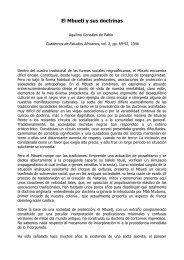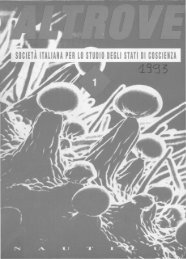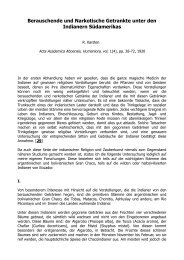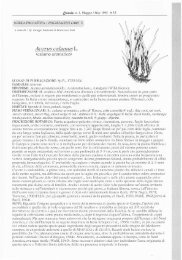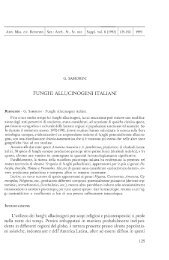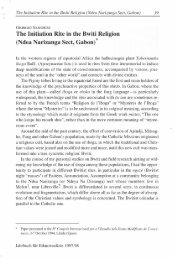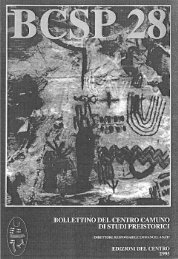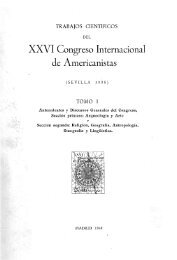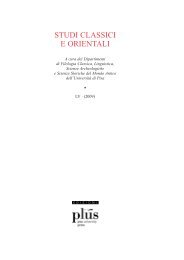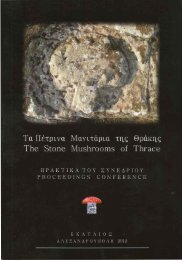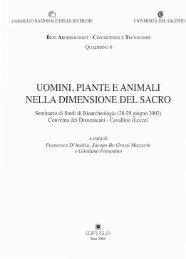Gli "alberi-fungo" nell'arte cristiana - Giorgio Samorini Network
Gli "alberi-fungo" nell'arte cristiana - Giorgio Samorini Network
Gli "alberi-fungo" nell'arte cristiana - Giorgio Samorini Network
Create successful ePaper yourself
Turn your PDF publications into a flip-book with our unique Google optimized e-Paper software.
GIORGIO SAMORINI<br />
100 Eleusis, n.s., n. 1, 1998<br />
anche in Slovacchia. In aggiunta, il fungo trovò spazio nei<br />
versi del poeta polacco Vaclav Potocki (1625-1699), il<br />
quale riferisce del suo potenziale di "causare follia più di<br />
quanto faccia l'oppio". Similmente, in Inghilterra, John<br />
Parkjnson, nel suo Theatricum Botanicum (1640), include<br />
dei particolari sul "fungo che rende folle". L'espressione<br />
colloquiale austriaca "ha mangiato quei funghi che inducono<br />
follia " (er hat verriickte Schwammerln gegessen) è riferito<br />
a stati di confusione<br />
mentale. Simili documenti<br />
di fonte storica<br />
sono scarsi e diffusi in<br />
un ampio territorio.<br />
Indubbiamente, si riferiscono<br />
ai funghi psicotropi"<br />
(GARTZ 1996:11-12).<br />
Ricordo ancora il<br />
mito croato preservatosi<br />
nei racconti popolari,<br />
che vede i funghi di agarico<br />
muscario nascere<br />
durante la notte di<br />
Natale (H. KLEJJN 1962,<br />
cit.in MORGA N<br />
1995:116-7).<br />
Turning to centraI and eastern Europe, we may consider<br />
Jochen Gartz's observations: "Clusius (1525-1609), the<br />
great physician and botanist, discovered the bolond gomba<br />
in Hungary. This mushroom was known under the German<br />
name Narrensch wamm ("fool's mushrooms"). It was used<br />
in rural areas, where it was processed into love potions by<br />
wise men or javas asszony. At about the same time, this "<br />
fool's mushroom" was documented in Slovakja as well. In<br />
addition, the mushroom<br />
found its way<br />
into the verses of<br />
Polish poet Vaclav<br />
Potocki (1625<br />
1699), who refers to<br />
its potential for<br />
"causing foolishness<br />
much like<br />
opium does".<br />
Similarly, in<br />
England, John<br />
Parkinson's<br />
Theatricum<br />
Botanicum (1640)<br />
includes details<br />
about a "foolish<br />
mushroom". The<br />
Tornando alle rap Fig. 17 . Pittura di un manosclìtto alchemico del xrv secolo d.C. (da B ENNETI et al., 1995 :24 1) Austrian colloquiaI<br />
Painting from a 14th C AD alchemical manuscript (fro/1/ BENNE:TT et al.. 1995:241)<br />
presentazioni di alberofungo,<br />
per quanto riguarda<br />
i documenti fin qui presentati non possiamo essere certi<br />
dell'intenzione degli artisti nel raffigurare funghi psicoattivi;<br />
anzi, per diversi fra questi è assai probabile che non vi<br />
sia stata questa intenzione. Ma per quanto riguarda i due<br />
documenti che presento di seguito, credo che possiamo<br />
sospettare fortemente l'intenzione da parte degli artisti di<br />
arricchire le scene di un messaggio esoterico associato ai<br />
fun ghi psicoattivi.<br />
CHRIS BEN EIT, LYNN e JU DY OSBURN (1995) hanno<br />
scritto un saggio sulla storia della Cannabis. Una pagina di<br />
questo libro è dedicata all'A. muscaria, con la presentazione<br />
della sorprendente immagine di fig. 17. Questa pi ttura è<br />
presente in un manoscritto alchemico datato al XIV secolo,<br />
conservato presso la Bodleian Library di Oxford<br />
(Inghilterra). Riporto l'interpretazione della pittura offerta<br />
da Bennett e colI.: " ... Ia pittura alchemica mostra un uomo<br />
inebriato da funghi A. muscaria. Egli stringe un fun go nella<br />
sua mano [sinistra], mentre danza tenendo l'altra mano<br />
sulla fron te, come se la rivelazione fosse troppo intensa.<br />
Dietro di lui cresce un albero con in cima un fungo maculato"<br />
(BEN NETT et al. 1995:240).<br />
L'albero in questione è un albero-fungo, del tipo<br />
"Plaincourault", dotato dei quattro particolari che lo caratterizzano.<br />
L'uomo è raffigurato in una posizione che può<br />
effettivamente ricordare un passo di danza, ma potrebbe<br />
anche essere più semplicemente raffigurato nell' atto di barcollare<br />
per via degli effetti troppo intensi del fungo: lo conexpression<br />
"he ate<br />
those madnessinducing<br />
mushrooms" (er hat verriickte Schwammerln<br />
gegessen) refers to states of mental confusion. Historic<br />
source materials such as these are scarce and widely-scattered.<br />
Undoubtedly, they refer to psychotropic mushrooms"<br />
(GARTZ 1996:11-12).<br />
I remember the old Croatian myth preserved in folk<br />
tales, according to which the fl y-agaric springs up on<br />
C hristmas night (H. Kleijn 1962; ciI. in MORGAN 1995: 116<br />
7).<br />
With regard once more to mushroom-tree re presentations,<br />
we cannot be sure that the artists wished to represent<br />
psychoactive mushrooms; indeed, it is unlikely that thi s<br />
was the case. However, in the two examples I present<br />
below we have good reason to suspect that the artists<br />
wished to supplement the depicted scenes with an esoteric<br />
message associated with psychoactive mushrooms.<br />
CHRlS BENNETT and LYNN and JUOY OSB URN (1995)<br />
wrote an essay on the history of Cannabis, one page of<br />
which is dedicated to A. muscaria. Here they present the<br />
surprising image (fig. 17) taken fro m a 14th century manuscript<br />
on alchemy from the Bodleian Library in Oxford<br />
(England). Bennet and Osburn comment as follows: " ...<br />
the alchemical painting show a man intoxicated on<br />
Amanita muscaria mushrooms. He c1utches one mushroom<br />
in his [left] hand as he dances about holding his other hand<br />
to his forehead as if the reve1ation is too intense. Behind



